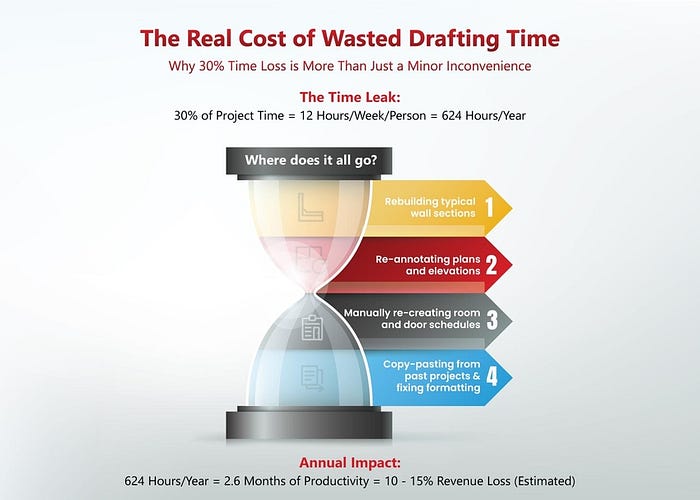How Architects Can Save 30% Time on Drafting Tasks
 Virtual Building Studio
Virtual Building Studio
It’s 8 PM. You’re redrawing standard bathroom details, again. Not because you want to, but because the project needs it, and no one has time to build a reusable detail library. Sound familiar?
Studies and internal audits show that small architecture firms lose up to 30% of billable project time redrawing the same walls, casework, schedules, and standard sections, project after project. This isn’t just inefficiency; it’s a slow bleed of time, money, and creative energy.
Here’s what that wasted time really costs:
Lost Revenue: Hours that could’ve been billed or used for new work vanish.
Burnout: Staff stretched thin doing repetitive, non-design tasks.
Stifled Creativity: Less time for real design thinking and innovation.
Missed Deadlines: Delays that frustrate clients and hurt your reputation.
Stunted Growth: You can’t scale if every project starts from scratch.
In this blog, we’ll break down the causes behind this productivity gap and share how small firms can fix it without overhauling their entire workflow.
The Reality of Repetitive Drafting in Architecture Firms
Repetitive architectural drafting refers to the manual recreation of standard project components such as floor plans, sections, elevations, room schedules, and detail sheets across multiple projects. Instead of leveraging reusable content or parametric tools, many small firms still redraw these elements from scratch, consuming valuable project hours.
\>> Download Architectural Drafting Workflow Audit Checklist
The Root Causes — Why does this still happen in 2025?
Despite advancements in design tech, these inefficiencies persist due to a few core issues:
Lack of dedicated production staff: In small firms, the same architect often handles design, documentation, client coordination, and QA, leaving little bandwidth for streamlining production tasks.
One person, many hats: Junior or mid-level staff are frequently overburdened, switching between concept design and technical drawings without time to build reusable content.
Inefficient use of BIM/CAD tools: Many firms use powerful platforms like Revit or AutoCAD but underutilize features like Revit families, groups, view templates, or project standards.
No automation or standard template system: Without a solid library of details, sheet templates, or scripting workflows like Dynamo or AutoLISP, teams are bound to redrawing.
The result? A recurring loss of efficiency and a growing backlog of preventable manual work, hurting profitability and project delivery speed.
Press enter or click to view image in full size

Practical Strategies to Reclaim Your Time — Workflow Optimization for Architecture Firms
Reclaiming that 30% of time lost to repetitive drafting isn’t about working harder; it’s about building a smarter, more efficient workflow. Below are four proven strategies that help small architecture firms streamline production, reduce manual tasks, and regain valuable billable hours.
Leverage BIM for Production Drafting
Modern BIM platforms like Revit offer far more than 3D visualization — they’re powerful production engines when used strategically.
Use parametric Revit families for doors, windows, furniture, and fixtures. These smart components adapt across project types and reduce rework.
Build project templates with pre-set views, title blocks, filters, and sheet setups to eliminate redundant setup tasks.
Group and link models to manage complex buildings and phased workflows efficiently.
By moving away from 2D CAD blocks and embracing BIM-driven documentation, firms can eliminate duplication and boost quality control.
Watch Now : Wearing Too Many Hats? How Architects Delegate for Success
Outsource Repetitive Drafting to a Dedicated Team
Not all production work needs to be done in-house. Outsourcing can relieve bottlenecks and free your core team to focus on higher-value tasks.
Offload tasks like redlining, construction documentation, as-built modeling, or scan-to-BIM from point clouds.
Remote BIM partners can deliver quick turnaround on routine work, allowing internal architects to concentrate on design, client engagement, and project management.
Flexible models like dedicated drafting teams or task-based billing enable scalability without the overhead of full-time hires.
Think of it as extending your studio, without expanding your payroll.
Adopt Reusable Libraries & Templates
Standardization is a force multiplier. By building and maintaining a robust content library, firms can eliminate repetitive drafting almost entirely.
Maintain shared libraries of standard details, wall types, sheet layouts, and title blocks.
Use discipline-specific templates like residential vs. commercial to fast-track project start-up.
Centralize project assets so that your team isn’t constantly searching or recreating elements.
Consistency doesn’t stifle creativity; it accelerates delivery.
Learn How : The Architect Reclaimed Her Time and Scaled Without Burning Out
Automate Where Possible
Automation tools save time by handling the most repetitive tasks in your production workflow.
Use Dynamo scripts for Revit or AutoLISP routines for AutoCAD to automate tasks like:
View naming and sheet creation
Tagging rooms or elements
Generating schedules
Automated QC checks can detect modeling errors or missing annotations before they impact deadlines.
Even automating 10 minutes/day adds up to over 40 hours/year per team member.
By adopting a hybrid strategy of smarter tools, process standardization, and strategic outsourcing, small architecture firms can dramatically reduce drafting fatigue and get back to what matters: great design and client value.
\>> Download Architectural Drafting Workflow Audit Checklist
Implementation: Making the Shift & Overcoming Barriers
Even with the best strategies in hand, transforming how your firm handles drafting requires deliberate execution. The key is not to aim for a total overhaul overnight, but to build momentum through small, measurable wins.
Here’s how to begin the transition and sustain it.
\>> Start Small, Then Scale
\>>Dedicate Time — It’s an Investment
\>>Leverage Existing Resources
\>>Get Staff Training & Buy-in
\>>Assign a “Keeper of Standards”
\>>Measure the Impact
With the right approach, reclaiming lost time isn’t a dream — it’s a step-by-step, trackable process that reshapes how your firm works for the better.
Explore more about Architectural Drafting Workflow Audit Checklist
Subscribe to my newsletter
Read articles from Virtual Building Studio directly inside your inbox. Subscribe to the newsletter, and don't miss out.
Written by

Virtual Building Studio
Virtual Building Studio
Helping Architecture Firms Scale with On-Demand, US-Trained Architects (Level I, II & III) At Virtual Building Studio, we specialize in empowering architecture firms to scale quickly and efficiently with top-tier, US-trained architects (Level I, II & III)—ready to join your team on demand. Why Leading Architecture Firms Trust Us Top Architecture firms rely on us to expand their architectural teams and boost project efficiency. Our proprietary DRM Solution ensures access to the top 1% of US-trained architects (Level I, II & III)—delivered within just 3 days. Why Choose Us? ✅ Top 1% US-Trained Architects (Level I, II & III) – Tap into a range of skills and expertise. ✅ One-Month Risk-Free Trial – Experience our services with zero long-term commitment. ✅ Flexible, No Long-Term Contracts – Scale your team based on project needs. ✅ 15-Day Notice Period – Easy transitions, no hassle. ✅ Diverse Talent Pool – Access highly specialized architects for all project phases. ✅ Cultural Fit & Seamless Integration – Architects that blend effortlessly with your US-based teams. ✅ High Client Satisfaction – Supported by a Customer NPS of 86. ✅ 24/7 Productivity – Keep projects on track with round-the-clock support. Let’s Build Your Dream Team Today! Ready to expand your architectural team with top-tier, US-trained architects (Level I, II & III)—without increasing costs? Let’s connect! Start your risk-free trial today and discover a smarter way to scale your firm. 🚀 Contact us today!